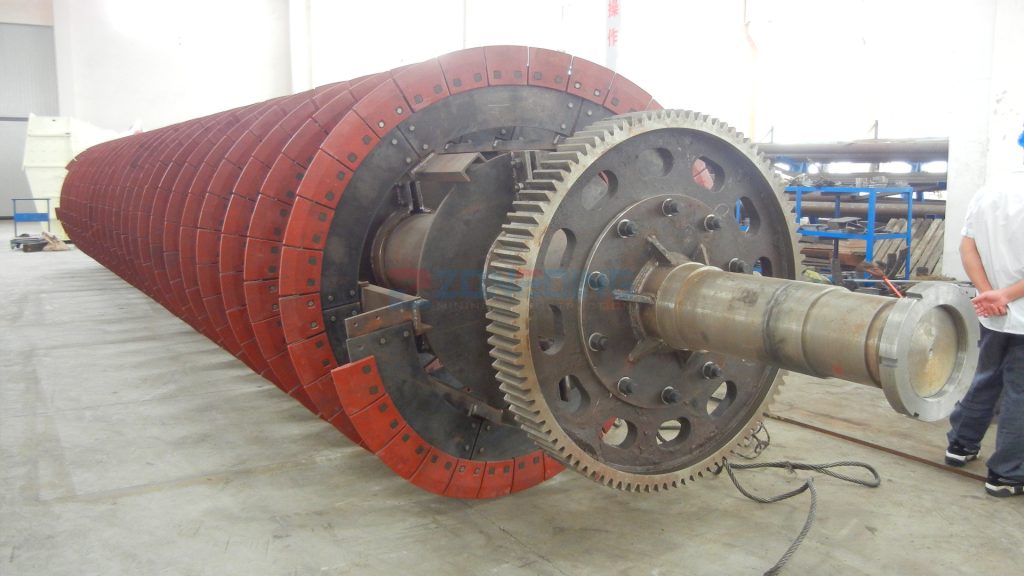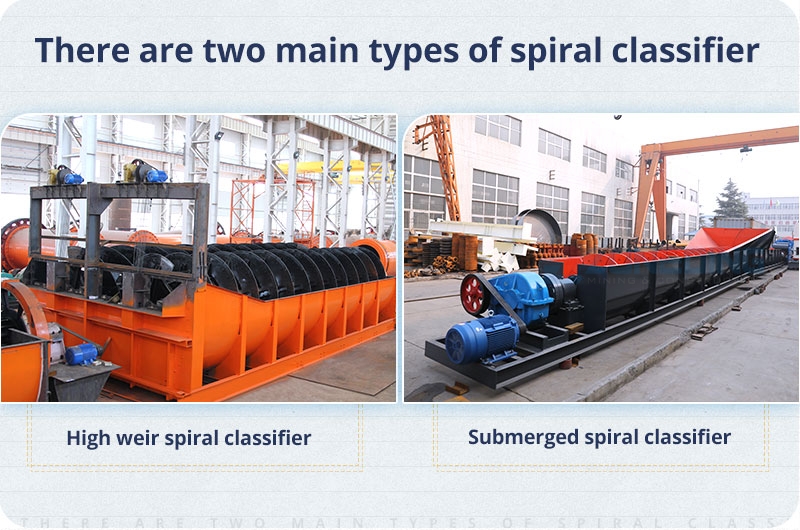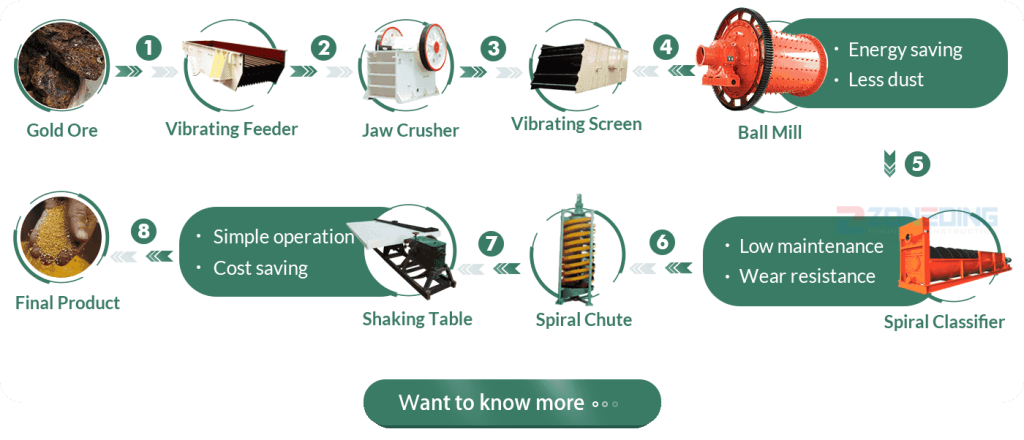Search the whole station Crushing Equipment
Spiral classifiers can grade different particles in ore slurry during the metal beneficiation process as well as deslime and dehydrate in the washing operation.
The spiral classifier is a device that utilizes the principle of different sedimentation speeds of solid particles in a liquid based on their specific gravity for mechanical classification. It widely applys in closed-circuit processes in conjunction with ball mills to separate and classify ore sand in mining plants. It can apply in gravity separation plants for classifying ore sand and fine mud, as well as in metal ore dressing processes for size classification of ore pulp. Additionally, it finds application in de-sliming and dewatering operations during ore washing.

Spiral classifiers offer several key advantages in mineral processing, making them a popular choice for efficient material separation. These benefits lead to higher product quality and lower operational costs.

You should consider using a spiral classifier for the following reasons:
Types: There are four classifiers: high weir single spiral and double spiral, submerged single spiral and double spiral.

Spiral classifiers are versatile and used across many industries for separating solids from liquids. Their flexibility makes them essential for a variety of processes.

The work principle of a spiral classifier relies on the difference in settling velocities of particles in a liquid medium. Larger, denser particles settle faster and are conveyed to the bottom, while finer particles remain suspended and overflow with the liquid. It is based on the different sedimentation speeds of solid particles in a liquid due to their varying specific gravities.
When the ore pulp enters the tank from the side feed inlet, it forms a sedimentation zone at the bottom of the tank. The slowly rotating spiral provides a certain degree of agitation to the pulp. After agitation, the light and fine particles suspend on the surface, forming an overflow that flows over the weir at the end of the water tank into the next mineral processing step. The heavy and coarse particles settle at the bottom of the tank, forming a return sand that is transported by the spiral to the discharge port for removal, thus achieving the desired classification.

A spiral classifier works through sedimentation and settling velocity. Heavier particles settle faster due to gravity, while lighter particles remain suspended. The spiral then conveys the settled particles upwards, achieving separation.
The process begins with the slurry entering the tank. The larger, heavier particles quickly settle to the bottom due to their higher settling velocity. The rotating spiral flights then mechanically lift these settled particles up the inclined base of the tank. As the spiral moves the solids upwards, excess liquid drains back into the pool. The lighter, finer particles remain suspended in the liquid and are carried out of the tank as overflow. The single most impactful adjustment is the pool depth; too deep, and you lose fines, too shallow and you contaminate the overflow.
Spiral classifiers are highly versatile and can separate a wide range of materials based on size and density. This makes them useful in many different industries.
Common materials include:
The spiral classifier mainly consists of the following components:

The cost of a spiral classifier is influenced by several key factors. Understanding these will help you budget for your purchase and choose the right machine for your needs.
The main factors affecting the price are:
Selecting the right spiral classifier requires you to consider your specific operational needs. Following these steps will help you make the best choice.
You can optimize the operation of your spiral classifier by adjusting a few key parameters. This will help you achieve the best possible separation efficiency.
Here are the main parameters to adjust:
| Model | Spiral Diameter (mm) | Trough Length (mm) | Spiral rotate speed (r/min) | Processing capacity(t/d) | Motor Power(kw) | Dimensions(mm≤) | Total weight (t) | ||||
| Sand -return | Overflow | For driving | For lifting | Length | Width | Height | |||||
| FG-3 | 300 | 3000 | 12-30 | 80-150 | 20 | 1.1 | —- | 3850 | 490 | 1140 | 0.7 |
| FG-5 | 500 | 4500 | 8-12.5 | 135-210 | 32 | 1.1 | —- | 5430 | 680 | 1480 | 1.9 |
| FG-7 | 750 | 5500 | 6-10 | 340-570 | 65 | 3 | —- | 6720 | 980 | 1820 | 3.1 |
| FG-10 | 1000 | 6500 | 5-8 | 675-1080 | 110 | 5.5 | —- | 7590 | 1240 | 2380 | 4.9 |
| FC-10 | 8400 | 675-1080 | 85 | 7.5 | —- | 9600 | 1240 | 2680 | 6.2 | ||
| FG-12 | 1200 | 6500 | 4-6 | 1170-1870 | 155 | 7.5 | 2.2 | 8180 | 1570 | 3110 | 8.5 |
| FC-12 | 8400 | 1170-1870 | 120 | 7.5 | 2.2 | 10370 | 1540 | 3920 | 11 | ||
| 2FG-12 | 6500 | 2340-3740 | 310 | 15 | 4.4 | 8230 | 2790 | 3110 | 15.8 | ||
| 2FC-12 | 8400 | 2340-3740 | 240 | 15 | 4.4 | 10370 | 2790 | 3920 | 17.6 | ||
| FG-15 | 1500 | 8300 | 4-6 | 1830-2740 | 235 | 7.5 | 2.2 | 10410 | 1880 | 4080 | 12.5 |
| FC-15 | 10500 | 1830-2740 | 185 | 7.5 | 2.2 | 12670 | 1820 | 4890 | 16.8 | ||
| 2FG-15 | 8300 | 2280-5480 | 470 | 15 | 4.4 | 10410 | 3390 | 4080 | 22.1 | ||
| 2FC-15 | 10500 | 2280-5480 | 370 | 15 | 4.4 | 12670 | 3370 | 4890 | 30.7 | ||
| FG-20 | 2000 | 8400 | 3.6-5.5 | 3290-5940 | 400 | 11-15 | 3 | 10790 | 2530 | 4490 | 20.5 |
| FC-20 | 12900 | 3210-5940 | 320 | 11-15 | 3 | 15610 | 2530 | 5340 | 28.5 | ||
| 2FG-20 | 8400 | 7780-11880 | 800 | 22-30 | 6 | 11000 | 4600 | 4490 | 35.5 | ||
| 2FC-20 | 12900 | 7780-11880 | 640 | 22-30 | 6 | 15760 | 4600 | 5640 | 48.7 | ||
| FG-24 | 2400 | 9130 | 3.67 | 6800 | 580 | 15 | 3 | 11650 | 2910 | 4970 | 26.8 |
| FC-24 | 14130 | 6800 | 490 | 18.5 | 4 | 16580 | 2930 | 7190 | 41 | ||
| 2FG-24 | 9130 | 13600 | 1160 | 30 | 6 | 12710 | 5430 | 5690 | 45.8 | ||
| 2FC-24 | 14130 | 13700 | 910 | 37 | 8 | 17710 | 5430 | 8000 | 67.9 | ||
| 2FG-30 | 3000 | 12500 | 3.2 | 23300 | 1785 | 40 | 8 | 16020 | 6640 | 6350 | 73 |
| 2FC-30 | 14300 | 23300 | 1410 | —- | —- | 17091 | —- | 8680 | 84.8 | ||
The feed rate, or how much material you put into the machine, has a major effect on its performance. You must control it carefully for good results.
Maintaining an optimal feed rate is critical for good performance. ZONEDING designs its classifiers to work best within a specific feed rate range.
Even reliable machines can have problems. Knowing the common issues and their solutions will help you minimize downtime.
Regular maintenance is key to keeping your spiral classifier running efficiently and for a long time. A simple maintenance routine can prevent major problems.
Your maintenance checklist should include:
While spiral classifiers are very effective, there are other technologies you can use for material separation.
Sometimes, these machines are used together. For example, a spiral classifier can be used to pre-treat material before it goes to a hydrocyclone, improving the overall efficiency of the system.
Spiral classifiers from ZONEDING are designed with features that provide excellent performance and a long service life.
Safety is the top priority when operating any heavy machinery. Following these precautions will help prevent accidents.
1.Are you a manufacturing or trading company?
We are manufacturer. Our factory established in 2004.
2.What is the after-service of your company?
We can provide the foundation drawing, installation service, training, spare parts and other service according to the customer’s requirements.
3. Which mineral processing method should I choose?
According to the properties of minerals, we will choose the treatment method that most suitable for you.
4. What machines are usually required for the whole production line?
Usually there are feeder, primary and secondary crushers, vibrating screen, ball mill, classifier, spiral chute, magnetic or flotation machine, dryer, etc. Equipment can be adjusted.
5. What is the final mineral concentration?
It depends on the ore grade. The final concentration of gold ore can reach 80-90%.
Your reliable source for high-capacity, heavy-duty ball mills engineered for mining, cement, and fine powder processing.
Zongding Machinery provides advanced ball mills and mineral processing equipment to help mining companies around the world process minerals more efficiently.
the best Ceramic Ball Mill manufacturers and their competitive prices. Our selection offers top-quality mills for various applications at affordable costs.
Efficient flotation machine for mineral processing at competitive prices. Maximum recovery and optimal grade for your mining operations.
A magnetic separator is a device that separates magnetic minerals from nonmagnetic minerals by applying a magnetic field.
“Optimize mineral processing with our high-efficiency Jigging Separator Machine! Ideal for gold, tin, coltan separation.
Gold Mine Wet pan mill applys in the gold mining industry and is one of the indispensable equipment in the modern gold mining industry. In addition, it can also apply for mining and processing other non-ferrous metals and precious metal ore…
Shaking tables for gold recovery, mineral processing at great prices. Learn more about our gold shaking table, prices, and processing today.
Designed to improve complete classification schemes, hydrocyclone meet a wide range of needs, balancing the cost of milling circuits with the performance of the equipment.
High efficiency concentrator is suitable to dewater concentrate and tailings in concentrator plant. Concentrate Thickener definition: Thickener (also known as thickener or agitator) is suitable for concentra…
loading…
已经是到最后一篇内容了!
We use cookies to ensure that we give you the best experience on our website. If you continue to use this site we will assume that you are happy with it.
Privacy Policy